February 25, 2008 12:42 PM CST
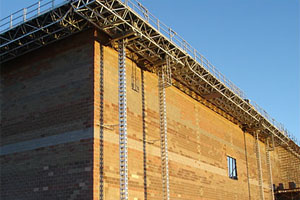
Mast climbing work platforms (MCWPs) have long been popular with large masonry companies, allowing them to do big jobs more quickly, easily and safely than with conventional scaffolding or other non-motorized, self-erecting scaffolds, says Jacques Laine, director of marketing for Fraco Products Ltd. in St-Mathias-sur-Richelieu, Quebec.
"More masonry companies in North America are using mast climbers," Laine says. "In fact, mast climbers are more in demand as productivity, safety and ergonomics become bigger priorities for masonry contractors."
Vincent Dequoy, president of L'Assomption, Québec-based Hydro Mobile, estimates that 70 percent of commercial masonry jobs in the Midwest use MCWPs, as do 50 percent to 60 percent of jobs in the Northeast. Only around 5 percent in the South and the West use MCWPs, but Dequoy says South and West markets are developing.
Although mast climbers cost between $35,000 and $100,000, the equipment can pay for itself within a couple years. "[Return on investment] is really fast and high with mast climbers, and this is a notion that a lot of contractors now realize," he says.
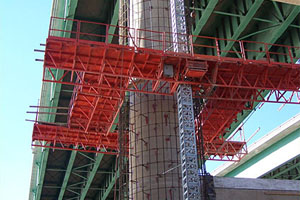
"The first savings are seen during the installation process, which significantly reduces the required number of laborers and erection time by requiring a fewer number of ties and having only one level to assemble," she says. "Rule of thumb is that to erect an MCWP system that fully wraps a building takes approximately 30 percent of the time it would take to do the same with a conventional scaffold system."
Manning says masons and materials can be lifted simultaneously to the exact spot where the work will be performed, creating an ergonomic working environment that increases production and reduces fatigue. Because the MCWP moves, workers no longer need to climb the scaffolding stairwell, saving climbing and recovery time.
"Additionally, loading the material onto the work platform and delivering it to the work site alleviates the need to schedule and wait for crane time or material hoist time, again cutting precious labor hours," she says.
Once masonry workers use a mast climber, they don't want any other system, says Mike Reddick, national sales manager for Hydek in Atlanta. MCWPs are perfect for big box store construction, like retail outlets and home centers, even when the buildings aren't very tall.
"At 25 feet and up, the mason is realizing a dramatic labor savings," Reddick says.
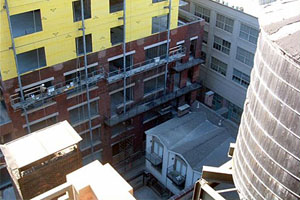
"It is generally accepted that mast climbers increase production by up to 35 percent," Laine says. "This gain can be explained by an improved safety feeling by workers and by the proven ability of mast climbers to fit any building configuration."
Mast climbers reduce workers' compensation claims, he says. Loads can be distributed anywhere on a work platform, which reduces the need for bending and heavy lifting.
"From the masonry contractor standpoint, benefits resulting from the use of mast climbers are mainly economic: quick installation, easy setup, gained productivity, labor savings, insurance cost reduction resulting from less compensation claims, etc.," Laine says.
Laine also says accidents resulting from falling debris, a consequent of bad scaffold planking, and falls from elevated scaffold are minimized with MCWPs. "Wall anchoring represents another important safety issue," he says. "Mast climbers are much easier to anchor into the building's structure."
Other scaffolding requires moving planks, which can cause injuries and mishandling problems, according to Hydro Mobile's Dequoy. Mast climbers let masons concentrate on laying bricks, not relocating planks.
"Mast climbers are not only safer on the jobsite, they are also a huge benefit for health in the long term," he says. "They are ergonomic, meaning that the bricklayer picks and lays the brick at the ideal body height."
Hydek's Reddick points out similar benefits. "It's safer because of the guard rails and also because the platforms are more stable," he says. "It reduces back injuries and repetitive stress injuries."
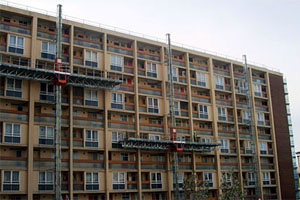
"The idea will be to strategically place training centers in the U.S. so that we can maximize on demand," O'Shea says, adding that he expects to have 10 opened within the next 18 months and, potentially, double to 20 in four years. Centers have already been appointed in Montreal, Boston and Atlanta.
O'Shea is currently forming a MCWP working committee, inviting people from OSHA, mast climbing manufacturers, labor organizations, and others to get together to write safe use regulations.
"What we've got to do is quickly and comprehensively compile safe use regulations," he says. "We're looking at a 12- to 18-month process for writing the documents and getting them to the publication stage."
O'Shea says safe-use regulations in other countries have identified who is responsible for which aspect of the scaffolding, informed regulatory and compliance groups how to identify risk during installation, and set training and accreditation standards.
"We're going to take the blueprint of those regulations, Americanize them, get input from the MCWP industry in the U.S., and fashion the document into something we can present to the industry as the benchmark for consistency, quality and safety," he says.
Manufacturers are also focusing on training. Hydro Mobile developed a training program and certification process in the 1990s for those operating the company's work platforms. The company has trained more than 5,000 people.
"The key factors for safety in the construction industry remain the qualifications, experience and training of the responsible persons. For this reason, we have created a dedicated structure called Hydro Mobile University," Dequoy says. "During training, we cover installation, utilization, optimization, safety and evaluation of loading capacities."
Alimak Hek offers a comprehensive training course at its facilities in Atlanta and Houston, Manning says. Training covers installation, dismantling, troubleshooting and specialized electrical systems.
Hydek teaches contractors how to set up and take down their mast climbers. "There are masons out there who own their own mast climbers and are capable of erection and dismantling," Reddick says. "We'll teach them how to do it. It's much easier than typical tube scaffolding."
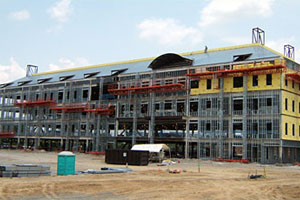
"That tells you about the potential for this equipment," O'Shea says. "I think as we go forward over the next 12 to 24 months, we'll see a large uptake in mast climber usage, giving further impetus for safe-use regulation."
Manning agrees that mast climbers will become more popular as business owners realize they're not a luxury.
"The mast climbing market will continue to grow at an unprecedented rate," she says. "As the industry becomes more and more focused on safe, economical alternatives and better educated on these types of machines, mast climbers will become the norm, rather than the exception."
New mast climbers will help shape MCWP's future. Bennu Parts & Service Inc. in Elk Grove Village, Ill., is bringing its new MCWP to the market this January. The continuous-climbing, two-tower system operates with the push of button, while an electro-hydraulic, self-levelling system keeps the platform balanced.
"What we have is an automated system that doesn't have to stop and reset every couple feet," says Jerry Castle, company president. "The load can be set on the scaffolding unbalanced, and the sensors will keep the platform level."
Castle says users can safely and efficiently raise and lower the scaffolding continuously. The push-button operation saves masons time and money by quickly putting the work platform at the height at which it's needed, while built-in safety features protect workers.
"A redundant manual backup, a spring-loaded safety dog, and a hydraulic internal brake give the operator confidence that the platform is safe and level," Castle says.
Alimak Hek has developed new platforms, called the HEK Modular System, that encompass both the mast climbing work platform and the transport platforms, Manning says. "Using three basic components, a large number of mast climbing work platforms and transport platforms, and combinations of the two, can be assembled."
In 2007, Hydro Mobile introduced a module system with a hoist and mast climber that's compatible with its F-Series scaffolding. In March, the company plans to launch a new product for the light- and medium-duty market.
Fraco also launched a new mast climber last year. "The ACT-4 work platform combines safety, quickness and flexibility," Laine says.
New Heights
Efficiency, safety, innovation drive mast climber market
By Brett Martin

Photo courtesy of Hydek.
Mast climbing work platforms (MCWPs) have long been popular with large masonry companies, allowing them to do big jobs more quickly, easily and safely than with conventional scaffolding or other non-motorized, self-erecting scaffolds, says Jacques Laine, director of marketing for Fraco Products Ltd. in St-Mathias-sur-Richelieu, Quebec.
"More masonry companies in North America are using mast climbers," Laine says. "In fact, mast climbers are more in demand as productivity, safety and ergonomics become bigger priorities for masonry contractors."
Vincent Dequoy, president of L'Assomption, Québec-based Hydro Mobile, estimates that 70 percent of commercial masonry jobs in the Midwest use MCWPs, as do 50 percent to 60 percent of jobs in the Northeast. Only around 5 percent in the South and the West use MCWPs, but Dequoy says South and West markets are developing.
Although mast climbers cost between $35,000 and $100,000, the equipment can pay for itself within a couple years. "[Return on investment] is really fast and high with mast climbers, and this is a notion that a lot of contractors now realize," he says.

Photo courtesy of EZ Scaffold Corp.
Economical and Efficient
MCWPs are more economical and efficient than conventional scaffolding, says Paula Manning, business development manager, mast climbing platforms, for Houston-based Alimak Hek Inc. As a result, MCWPs save masonry contractors money."The first savings are seen during the installation process, which significantly reduces the required number of laborers and erection time by requiring a fewer number of ties and having only one level to assemble," she says. "Rule of thumb is that to erect an MCWP system that fully wraps a building takes approximately 30 percent of the time it would take to do the same with a conventional scaffold system."
Manning says masons and materials can be lifted simultaneously to the exact spot where the work will be performed, creating an ergonomic working environment that increases production and reduces fatigue. Because the MCWP moves, workers no longer need to climb the scaffolding stairwell, saving climbing and recovery time.
"Additionally, loading the material onto the work platform and delivering it to the work site alleviates the need to schedule and wait for crane time or material hoist time, again cutting precious labor hours," she says.
Once masonry workers use a mast climber, they don't want any other system, says Mike Reddick, national sales manager for Hydek in Atlanta. MCWPs are perfect for big box store construction, like retail outlets and home centers, even when the buildings aren't very tall.
"At 25 feet and up, the mason is realizing a dramatic labor savings," Reddick says.

Photo courtesy of Mastclimbers, Inc.
Safer Environments, Reduced Injury
One of the most highly touted benefits of MCWPs is safety. Manufacturers say mast climbers are safer than any other scaffolding."It is generally accepted that mast climbers increase production by up to 35 percent," Laine says. "This gain can be explained by an improved safety feeling by workers and by the proven ability of mast climbers to fit any building configuration."
Mast climbers reduce workers' compensation claims, he says. Loads can be distributed anywhere on a work platform, which reduces the need for bending and heavy lifting.
"From the masonry contractor standpoint, benefits resulting from the use of mast climbers are mainly economic: quick installation, easy setup, gained productivity, labor savings, insurance cost reduction resulting from less compensation claims, etc.," Laine says.
Laine also says accidents resulting from falling debris, a consequent of bad scaffold planking, and falls from elevated scaffold are minimized with MCWPs. "Wall anchoring represents another important safety issue," he says. "Mast climbers are much easier to anchor into the building's structure."
Other scaffolding requires moving planks, which can cause injuries and mishandling problems, according to Hydro Mobile's Dequoy. Mast climbers let masons concentrate on laying bricks, not relocating planks.
"Mast climbers are not only safer on the jobsite, they are also a huge benefit for health in the long term," he says. "They are ergonomic, meaning that the bricklayer picks and lays the brick at the ideal body height."
Hydek's Reddick points out similar benefits. "It's safer because of the guard rails and also because the platforms are more stable," he says. "It reduces back injuries and repetitive stress injuries."

Photo courtesy of Fraco Products.
Stepping Up Industry Training
Kevin O'Shea, training and safety director for Mastclimbers LLC, in Lithonia, Ga., and senior instructor for Aerial Work Platform Training, the North American branch of the International Powered Access Federation, is creating training centers that will offer standardized mast climbing training."The idea will be to strategically place training centers in the U.S. so that we can maximize on demand," O'Shea says, adding that he expects to have 10 opened within the next 18 months and, potentially, double to 20 in four years. Centers have already been appointed in Montreal, Boston and Atlanta.
O'Shea is currently forming a MCWP working committee, inviting people from OSHA, mast climbing manufacturers, labor organizations, and others to get together to write safe use regulations.
"What we've got to do is quickly and comprehensively compile safe use regulations," he says. "We're looking at a 12- to 18-month process for writing the documents and getting them to the publication stage."
O'Shea says safe-use regulations in other countries have identified who is responsible for which aspect of the scaffolding, informed regulatory and compliance groups how to identify risk during installation, and set training and accreditation standards.
"We're going to take the blueprint of those regulations, Americanize them, get input from the MCWP industry in the U.S., and fashion the document into something we can present to the industry as the benchmark for consistency, quality and safety," he says.
Manufacturers are also focusing on training. Hydro Mobile developed a training program and certification process in the 1990s for those operating the company's work platforms. The company has trained more than 5,000 people.
"The key factors for safety in the construction industry remain the qualifications, experience and training of the responsible persons. For this reason, we have created a dedicated structure called Hydro Mobile University," Dequoy says. "During training, we cover installation, utilization, optimization, safety and evaluation of loading capacities."
Alimak Hek offers a comprehensive training course at its facilities in Atlanta and Houston, Manning says. Training covers installation, dismantling, troubleshooting and specialized electrical systems.
Hydek teaches contractors how to set up and take down their mast climbers. "There are masons out there who own their own mast climbers and are capable of erection and dismantling," Reddick says. "We'll teach them how to do it. It's much easier than typical tube scaffolding."

Photo courtesy of EZ Scaffold Corp.
What's Next?
O'Shea expects to see a growth in the number of MCWPs used in the United States. He says the United States uses the same number of mast climber as Singapore, a country that's about 60 times smaller."That tells you about the potential for this equipment," O'Shea says. "I think as we go forward over the next 12 to 24 months, we'll see a large uptake in mast climber usage, giving further impetus for safe-use regulation."
Manning agrees that mast climbers will become more popular as business owners realize they're not a luxury.
"The mast climbing market will continue to grow at an unprecedented rate," she says. "As the industry becomes more and more focused on safe, economical alternatives and better educated on these types of machines, mast climbers will become the norm, rather than the exception."
New mast climbers will help shape MCWP's future. Bennu Parts & Service Inc. in Elk Grove Village, Ill., is bringing its new MCWP to the market this January. The continuous-climbing, two-tower system operates with the push of button, while an electro-hydraulic, self-levelling system keeps the platform balanced.
"What we have is an automated system that doesn't have to stop and reset every couple feet," says Jerry Castle, company president. "The load can be set on the scaffolding unbalanced, and the sensors will keep the platform level."
Castle says users can safely and efficiently raise and lower the scaffolding continuously. The push-button operation saves masons time and money by quickly putting the work platform at the height at which it's needed, while built-in safety features protect workers.
"A redundant manual backup, a spring-loaded safety dog, and a hydraulic internal brake give the operator confidence that the platform is safe and level," Castle says.
Alimak Hek has developed new platforms, called the HEK Modular System, that encompass both the mast climbing work platform and the transport platforms, Manning says. "Using three basic components, a large number of mast climbing work platforms and transport platforms, and combinations of the two, can be assembled."
In 2007, Hydro Mobile introduced a module system with a hoist and mast climber that's compatible with its F-Series scaffolding. In March, the company plans to launch a new product for the light- and medium-duty market.
Fraco also launched a new mast climber last year. "The ACT-4 work platform combines safety, quickness and flexibility," Laine says.
About the Author
Brett Martin is a freelance writer located in Shakopee, Minn. with several years of construction and writing experience.


















